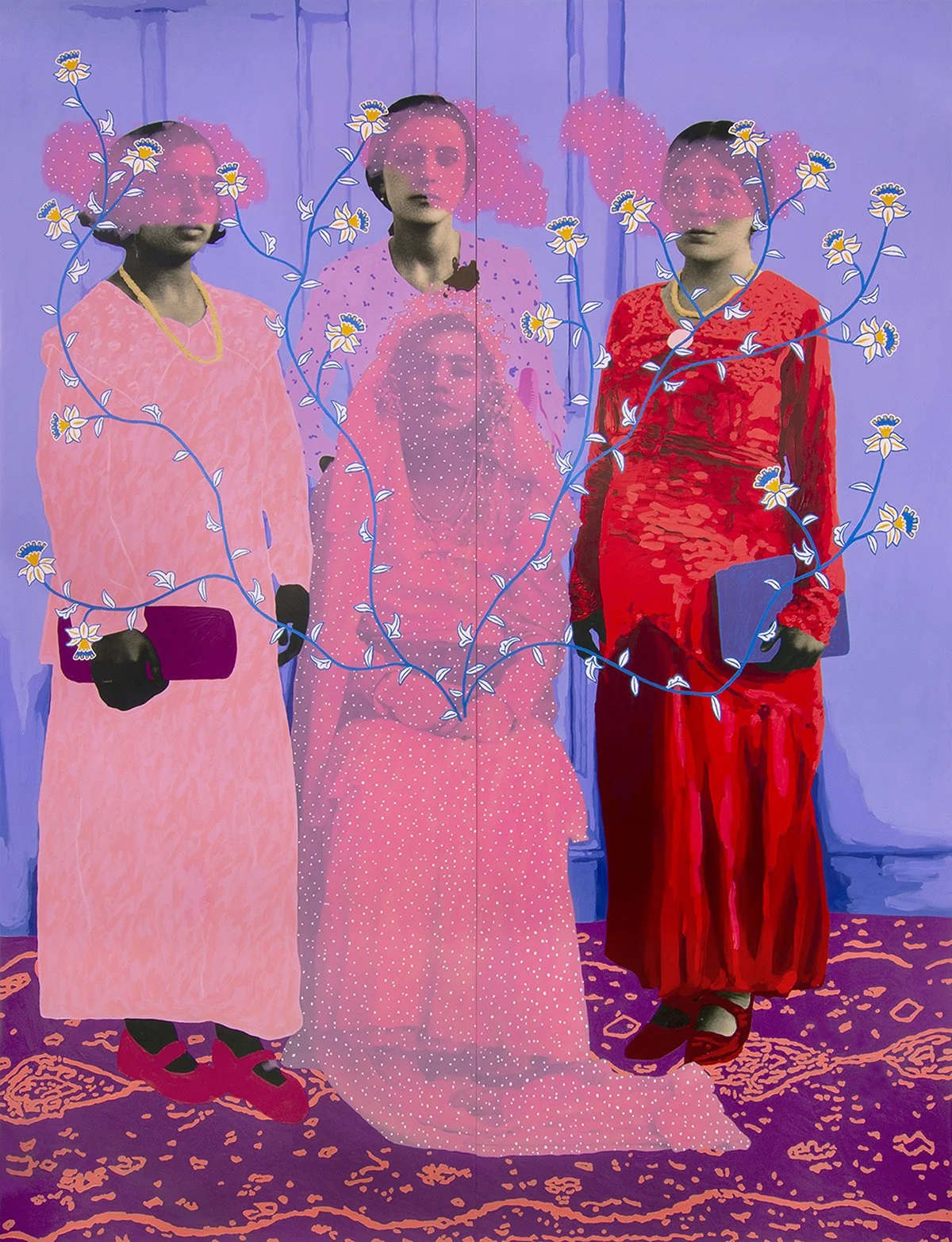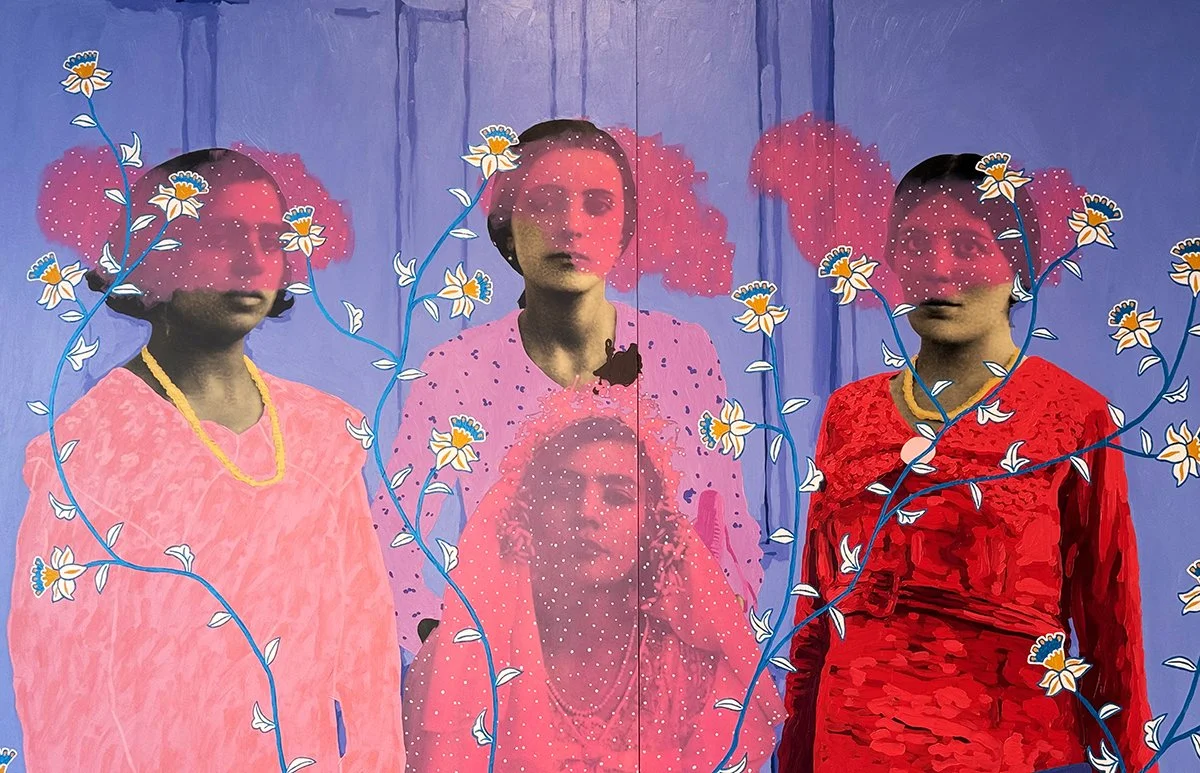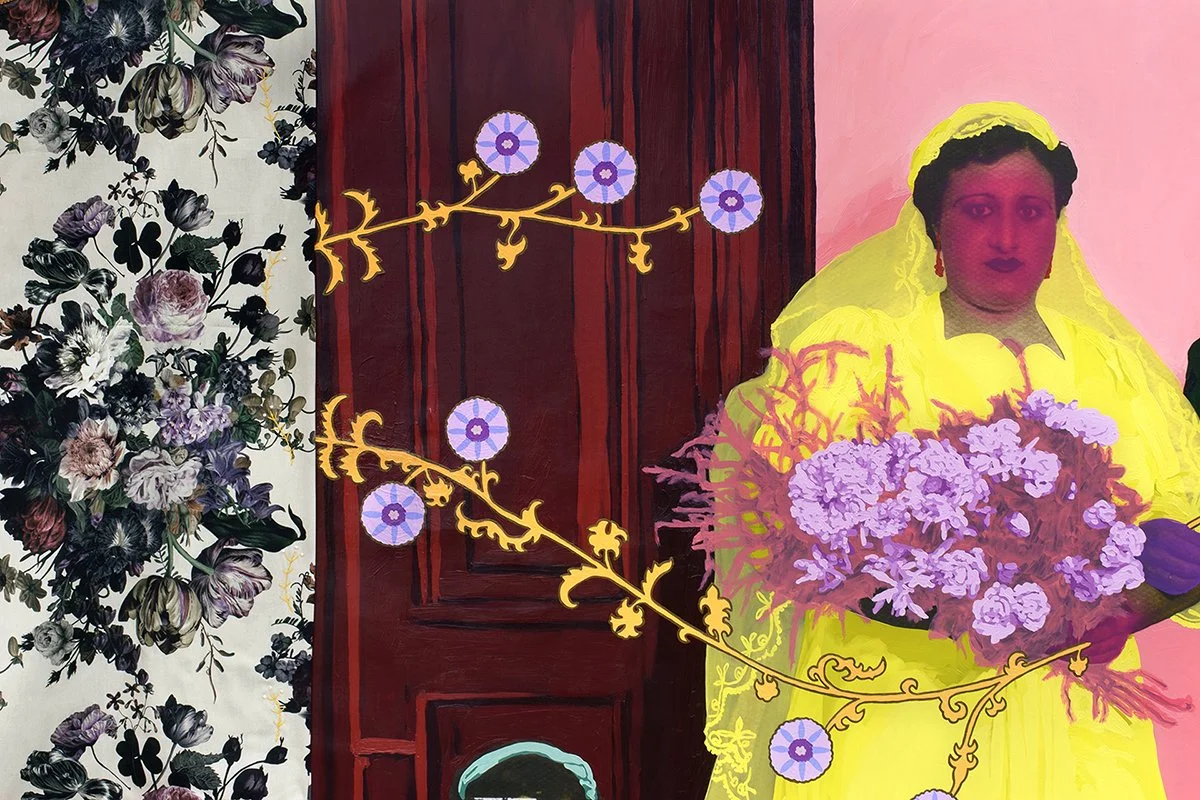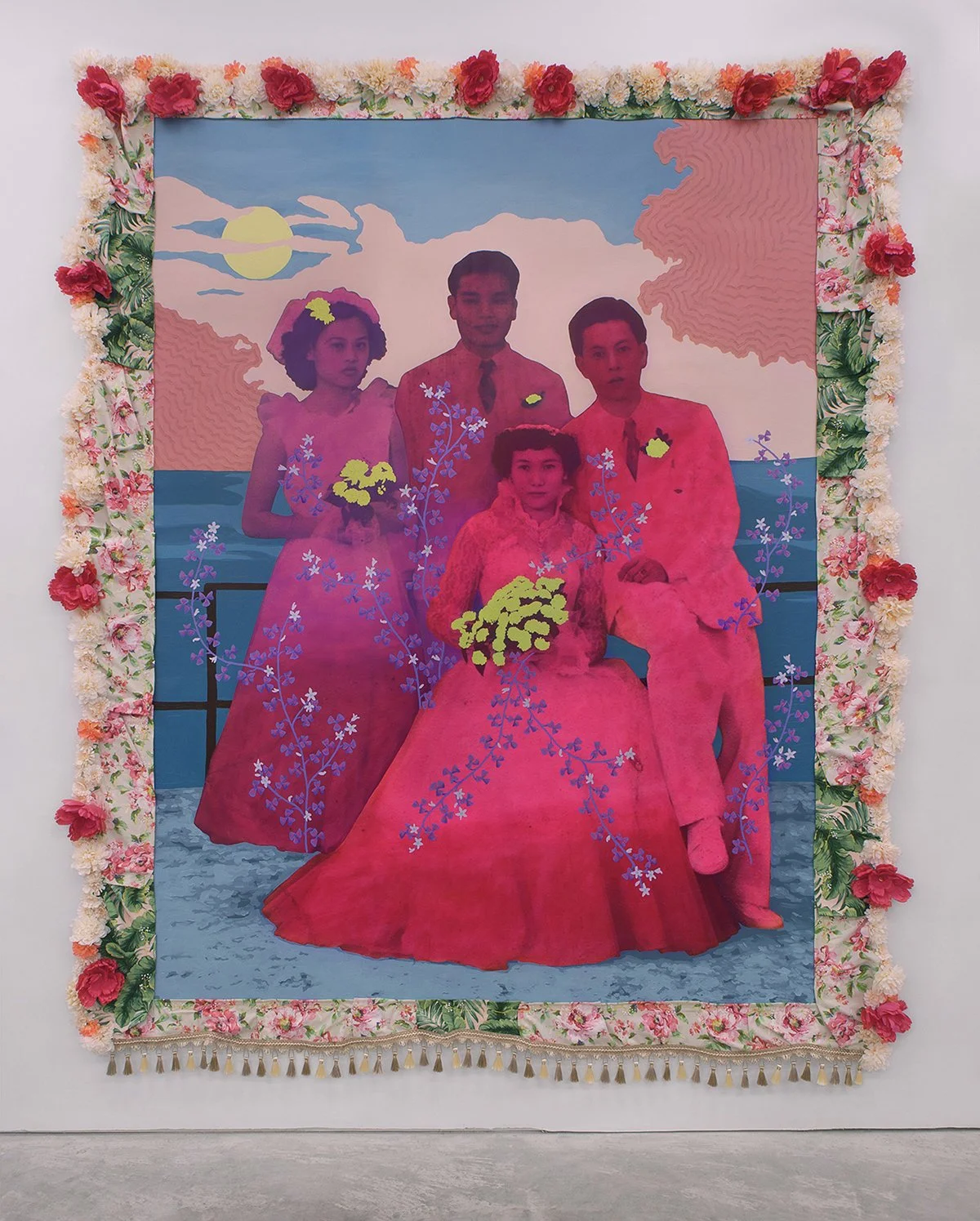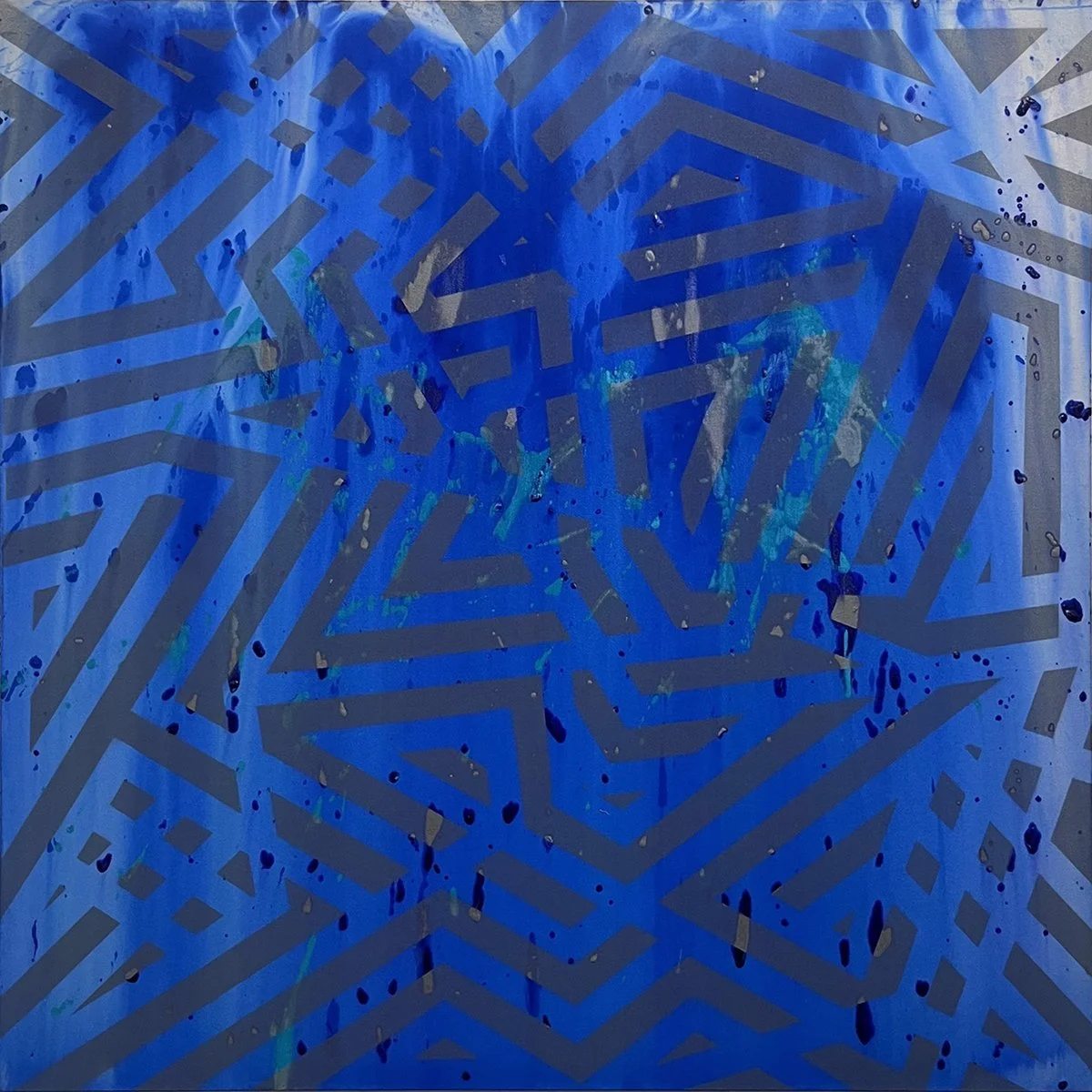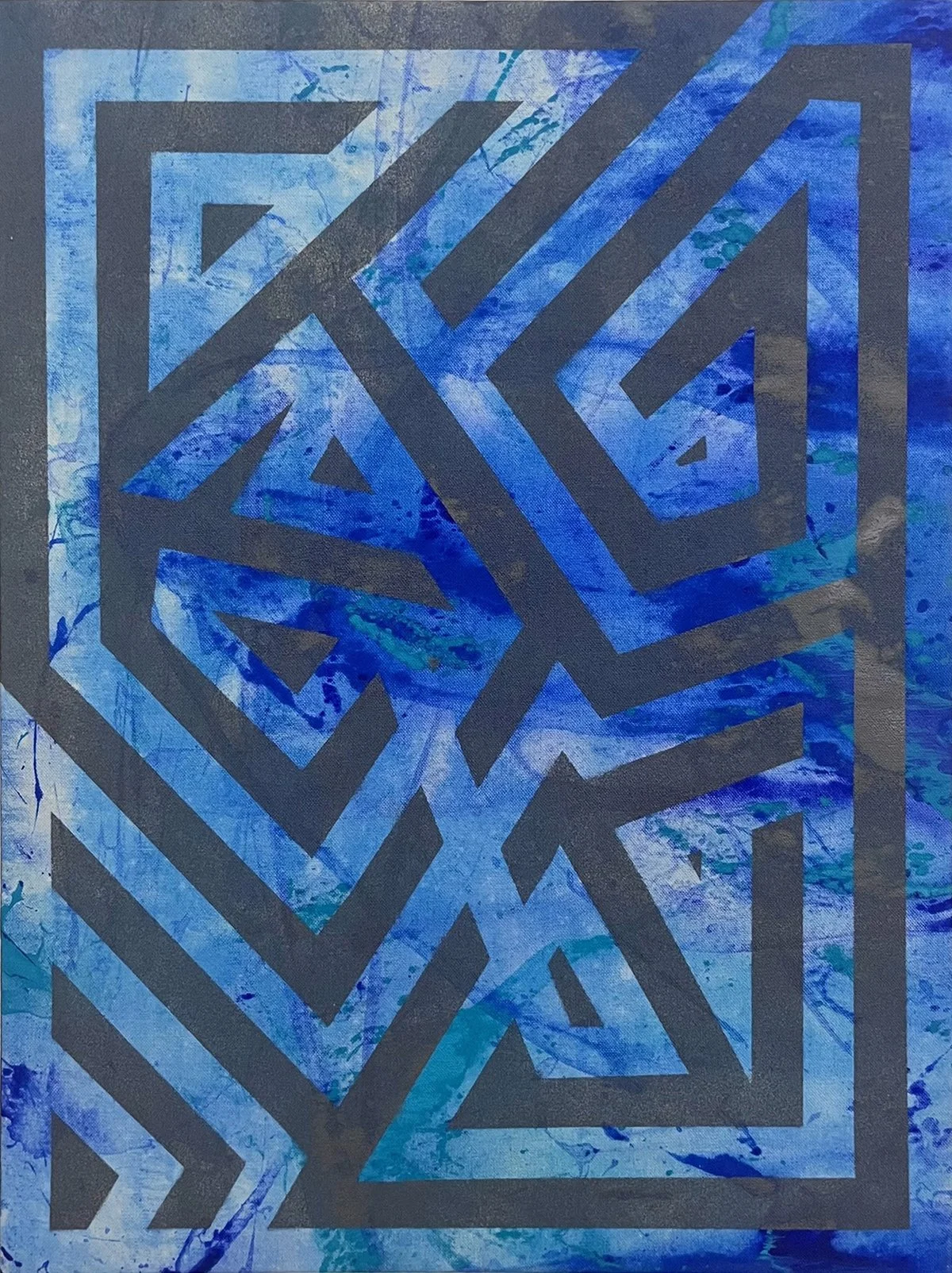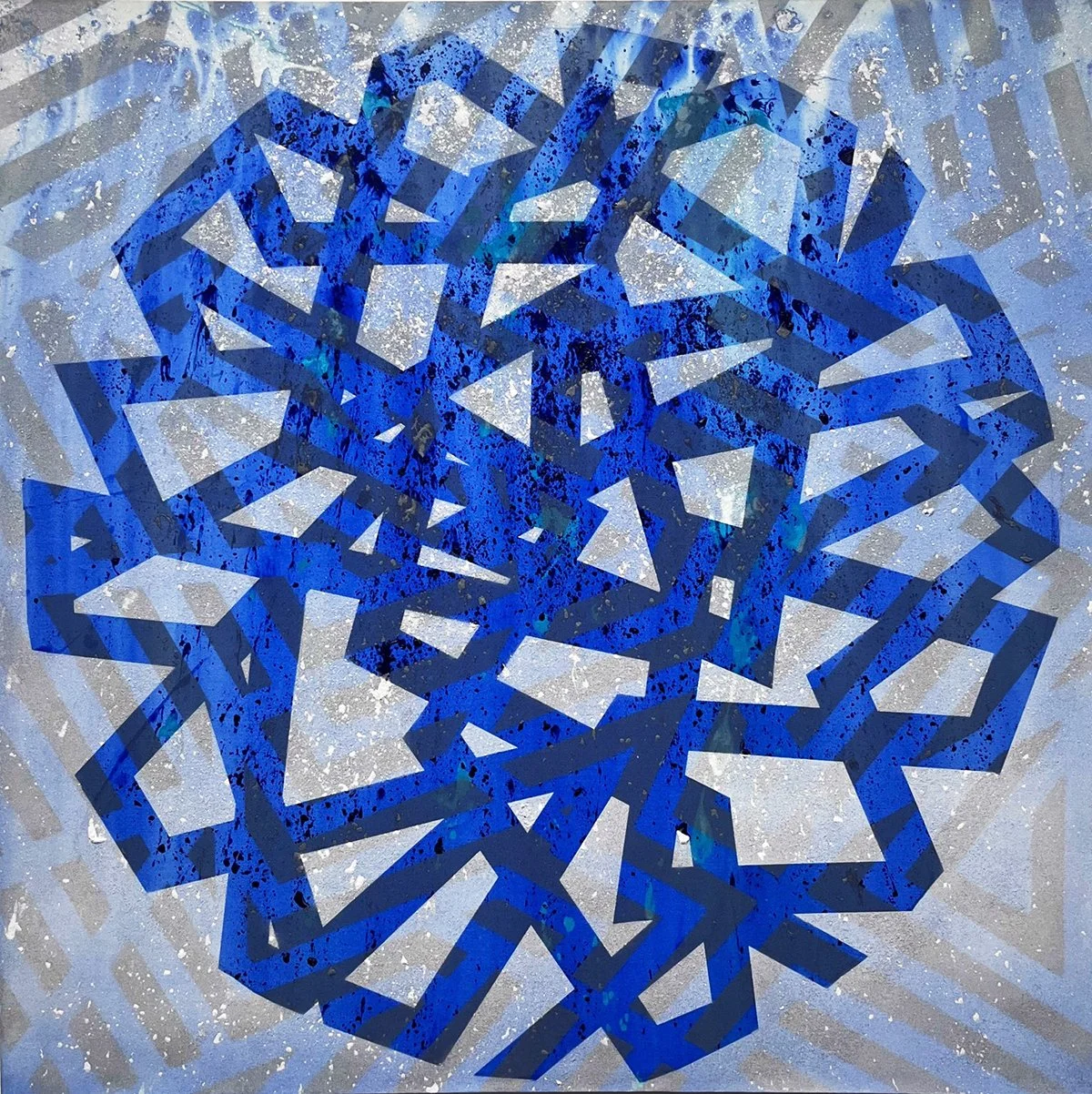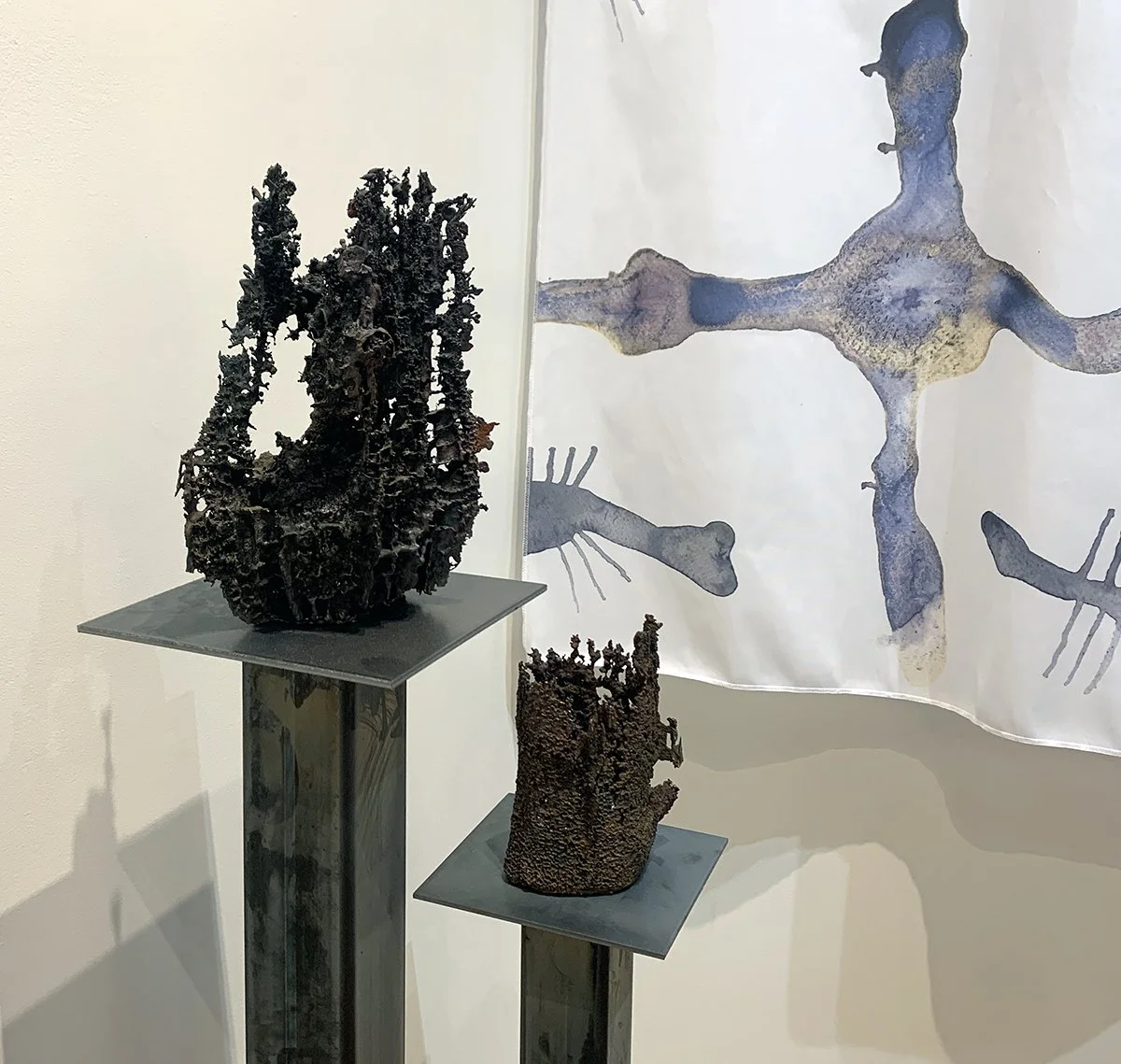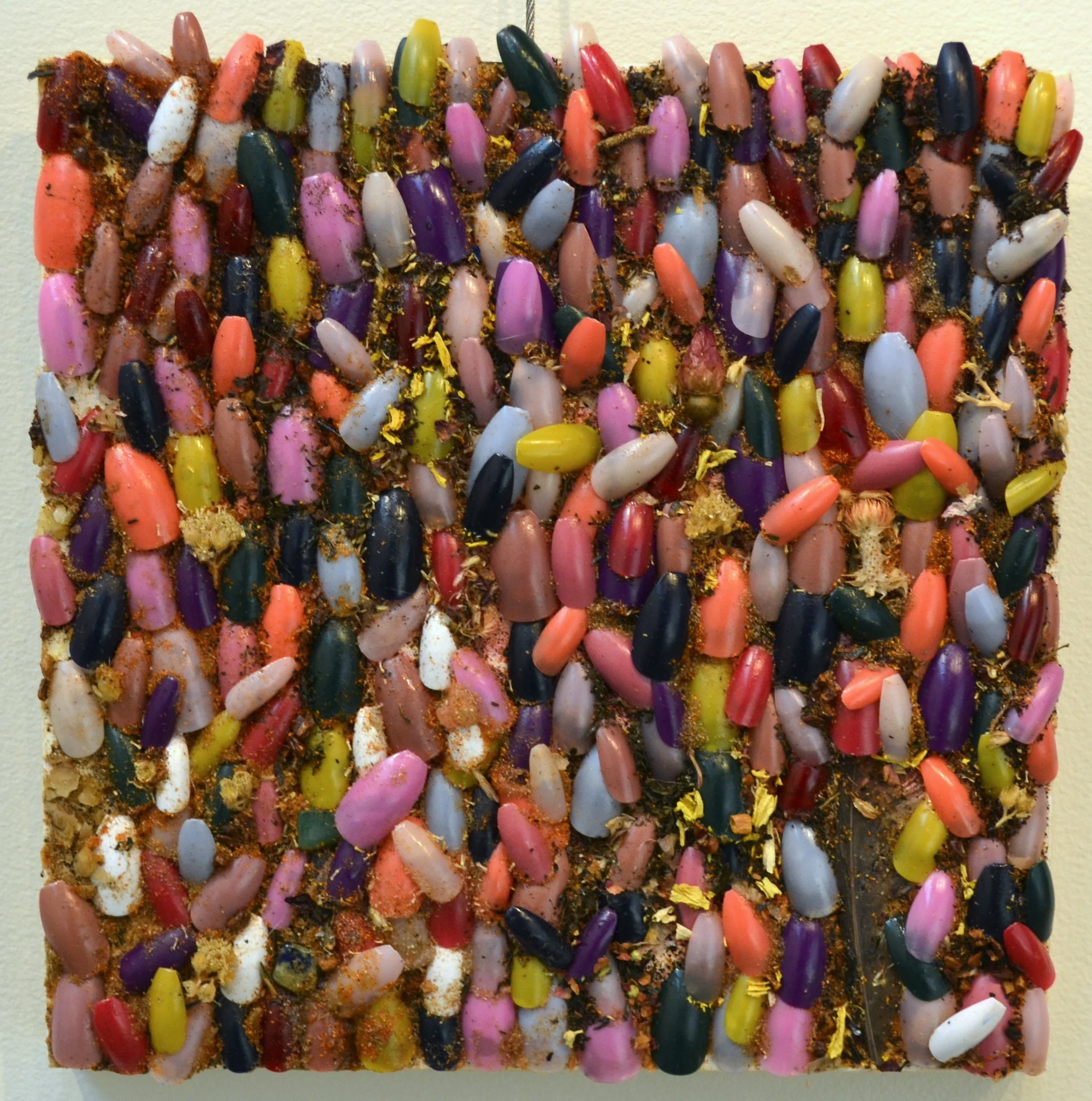The Spectrum of Blue | Before These Witnesses
Ya La'Ford: The Spectrum of Blue
Daisy Patton: Before These Witnesses
K Contemporary
1412 Wazee Street, Denver, CO 80202
September 20–October 25, 2025
Admission: free
Review by Kamden Hilliard
K Contemporary in downtown Denver is currently hosting Daisy Patton's exhibition Before These Witnesses and Ya La'Ford's The Spectrum of Blue. Together, they offer dignity to what is often lost and model critical-minded, liberatory approaches to the appreciation and recovery of details.
An installation view of works by Daisy Patton in the exhibition Before These Witnesses at K Contemporary. Image by Kamden Hilliard.
In these two exhibitions, the artists use a variety of technical and intellectual interventions, highlighting archival wedding photos and the color blue. Daisy Patton begins with archives—online and in the back of dusty antique shops—to find wedding photos that have fallen out of family collections: Bulgarian couples, Chinese wedding parties, queer wedding receptions, and other diverse collectives. She transforms these intimate records into enlarged prints, to which she applies bright oil paints, fabric, embroidery, found antique mirror frames, fringe, and buttons, enlivening these moments and reinvigorating their visual and emotional appeal.
An installation view of works by Ya La'Ford in the exhibition The Spectrum of Blue at K Contemporary. Image by Kamden Hilliard.
In somewhat of a departure from her larger-scale murals and sculptures, here Ya La'Ford works with rigorous geometry and hand-made pigments to develop a distinctly theoretical and fluid approach to meaning and color. Her show centers on black geometric forms set against a blue canvas. A set of bleach and alcohol-based applications renders the blue of the canvas unique and unpredictable, offering shades that extend far beyond the word "blue."
Daisy Patton, Untitled (The Bridal Party), 2022, oil on archival print mounted to panel, 90 x 68 inches. Image courtesy of K Contemporary.
Both shows center female artists utilizing their particular methods to call attention to details that have been forgotten or have gone unexpressed. The specifics of Daisy Patton's works include found objects, colors—oranges, pinks, yellows, purples, and blues—in their most flagrant acrylic shades, and flowers—in the form of imagery and silk reproductions. The latter lovely umbilical strands trace themselves like fingers over the images—in the photos and in the framing of several pieces. Patton applies these floral motifs directly to the life-sized images, blending graffiti and adornment.
A detail view of Daisy Patton’s Untitled (The Bridal Party), 2022, oil on archival print mounted to panel, 90 x 68 inches. Image by Kamden Hilliard.
A countercultural impulse, a secondary authorial voice, articulated by Patton's own hand, brings these faraway faces into the present. At the same time, the considerable size of the images, the downright loveliness of the flowers, the color stories, and the fabrics speak to a reverent softness at work. As much as Patton (re)imagines the past, she also listens to what it has to say.
Daisy Patton, Untitled (Wedding Portrait with Children and Rug and Orange Vines with Multicolored Flowers), 2024, oil on archival print mounted to canvas with fabric, embroidery, tassel fringe, floral buttons, and fabric flowers, 111 x 117 inches. Image courtesy of K Contemporary.
Consider Untitled (Wedding Portrait with Children and Rug and Orange Vines with Multicolored Flowers) (2024) where Patton collaborates with the original photo, reinforcing, drawing attention to, and complicating what is already visible, as it is all that remains of what once was.
In this work, a bride and groom pose in the center of the image while two children stand on either side and two others lie on a rug in front of the adults. Patton not only brings the couple and children into relief with an aesthetically brave combination of yellow, blue, and orange, but also their surroundings: there is a red set of doors behind the small group that become a framing device, which is only enriched by Patton's kimono-shaped frame.
A detail view of Daisy Patton’s Untitled (Wedding Portrait with Children and Rug and Orange Vines with Multicolored Flowers), 2024, oil on archival print mounted to canvas with fabric, embroidery, tassel fringe, floral buttons, and fabric flowers, 111 x 117 inches. Image courtesy of K Contemporary.
The painting ultimately suggests the form of a body, and the family at the center of the image serves as a kind of ballast or heart. The gallery setting of K Contemporary becomes a spaciotemporal extension of the wedding event, and the embroidery that frames most pieces in the show (except for a few framed with "found antique mirror frames") evokes the textures, shades, and sounds of the wedding ceremony within the gallery space itself.
Patton offers us the respect and opportunity to wonder with her: What are we missing here, and what can we do about it? Hers is not the work of restoration, but rather the resurfacing and recreation of events that have been abandoned by time and historical record. The artist's loving eye rescues these figures from an ocean of history that threatens to subsume them. The refreshed, resolved images help us ponder the specificities, pressures, and pleasures that drew each of these couples to one another.
Daisy Patton, Untitled (Wu 26 ul 1956 Keng U Photo 154 High, K.L.), 2025, oil on archival print mounted to canvas with fabric, embroidery, tassel fringe, floral buttons, and fabric flowers, 107 x 92 inches. Image courtesy of K Contemporary.
While these photographs have been separated from their histories, Patton has some information about them which is printed in the titles. For instance, all that is known of the original archival image of two couples posing in their wedding finery is included in the title of the painting the artist creates with it: Untitled (Wu 26 ul 1956 Keng U Photo 154 High, K.L.). If K.L. stands for Kuala Lumpur, this image may have been produced by the Keng U Photo Studio, once located at 154 High Street, perhaps...perhaps. However, it is from these “perhaps” that Patton delves into the shortcomings of history with her work.
In Patton's hands, the vibrant inner lives of her subjects fill those historical shortcomings, and her paintings (re)imagine those lost yet still essential elements of humanity. In this way, her work is annotational—it comments, responds, and reconstitutes, drawing attention toward what remains when so much is already forgotten.
An installation view of works by Ya La'Ford in the exhibition The Spectrum of Blue at K Contemporary. Image by Kamden Hilliard.
In The Spectrum of Blue, Ya La'Ford effectively focuses on the gap between experience and the often-inadequate containers that attempt to name it. Using a variety of techniques, she produces blues that ooze down the canvas, blues that flow across surfaces, blues light as holidays, blues heavy and powdery, vibrant blues, dull blues, and blues so blue they stretch beyond the language that names them. In her works, La’Ford employs a traditional egg wash binding agent, hand-made pigments, and alcohol and bleach treatments. Her flowy shapes are grounded by a series of exacting, heavy, black lines that provide her canvases with tension and structure, staging a conflict between the structural and the abstract—the flexible and the rigid.
Ya La'Ford, Liminal Fragments, 2025, acrylic, ink, pigment, glue, alcohol, egg, bleach, and resin on canvas, 24 x 18 x 1.5 inches. Image by Kamden Hilliard.
La’Ford identifies sensations, feelings, and meanings beyond pre-existing language, even for blue. She reminds us that there is no hard count on the colors and shades of this world because color, like feeling, is spectral and often at home in contradiction or the in-between. Works like Liminal Fragments, which features an overall maze pattern in blue over a dark ground, are streaky and full-throated, with azure and indigo hues, and a staccato-legato quality, all at once.
A detail view of Ya La'For’s, Liminal Fragments, 2025, acrylic, ink, pigment, glue, alcohol, egg, bleach, and resin on canvas, 24 x 18 x 1.5 inches. Image by Kamden Hilliard.
Her works take our shared emotional lives seriously, which are so rarely rendered respectfully by a one-word description. They instead suggest that we experience a myriad of unnamed emotions at any given moment. Liminal Fragments is structured by a unique geometry: the alcoves, corners, and spaces created by her solid lines are filled with a woozy, heady series of fluid blues, the same way that a tremendous sunrise is composed of colors beyond what language has chosen to name, and its light fills every vacancy of the material world below. Rather than a logical coherence, La'Ford offers her viewers an affective coherence, which makes space for the often-bizarre interior life of feeling.
Ya La'Ford, Pulse of Epiphany, 2025, acrylic, ink, pigment, glue, alcohol, egg, bleach, and resin on canvas, 24 x 18 x 1.5 in. Image courtesy of K Contemporary.
Pulse of Epiphany is remarkable for its scale: smaller than the other pieces in the show, it arrests attention with a thicker line—this time, dark gray-black on a blue ground—as well as a border on the interior edge of the image. The lines are balanced with a lighter blue that resembles a small quantity of dark blue ink dropped into a glass of water. Rather than shoving her ideas and experience inside of a preestablished grammar, La'Ford designs her own grammar, which is liberatory, not limiting.
Ya La'Ford, Alpenglow, 2025, acrylic, ink, pigment, glue, alcohol, egg, bleach, and resin on canvas, 50 x 50 x 3.37 inches. Image courtesy of K Contemporary.
Consider La'Ford's Alpenglow, a composition of meandering lines that form a circle in the center of the canvas. It plays with two intensities of blue, one vibrant and the other a touch faded. Together, they convey a spectrum of intensities that extends beyond a value hierarchy. There is no being too bright or too dull in this painting because it does not establish a hierarchy of beauty.
Alpenglow is the reddish light that strikes mountain tops during sunrise or sunset, when the disk of the sun dips below the horizon. Here, the phenomenon is transposed into blues, which communicate the same quality of light in a different color medium. As the more intense sun casts a paler shade on the mountain top, La’Ford's blues shares the same relation. It is as if the foregrounded image shines and casts a version of itself behind.
An installation view of works by Daisy Patton in the exhibition Before These Witnesses at K Contemporary. Image by Kamden Hilliard.
Daisy Patton's respectful imagination drags those forgotten back into the present with engaging color stories, delicate embroidery, fabric, and found frames that extend figures into the gallery space itself. That Patton resists/collaborates with the archive in the form of photos becomes a formal critique of how they render the past and who gets stuck in that past. Similarly, Ya La’Ford's theoretically infinite blue becomes an invitation to reckon with those feelings and thoughts that occur between, behind, above, and below our ever-regulated language. Blue becomes not a color, but a way through the world. For both Patton and La'Ford, detail— historical and emotional—becomes a site of worship, not for what was, but for what remains, and what can always be.
Kamden Hilliard (they/them) is a trans poet, educator, and fish keeper based in Colorado. You can find them online at kamdenihilliard.com.





